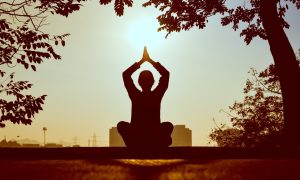We are in the midst of a global mental health crisis. Around 284 million people around the world – that’s 1 in every 13 people! – are affected by stress and anxiety disorder. The most common type of medically diagnosed anxiety is generalised anxiety disorder, or GAD. It’s characterised by chronic and excessive worry, which could lead to difficulty concentrating, troubled sleep, and increase fatigue and muscle tension.
The sad thing is that while GAD is entirely treatable, a majority of those affected often hesitate to seek treatment. The cultural stigma surrounding mental illness, exacerbated by a lack of medical and financial resources and a society that’s always so busy, keep people from getting the help they deserve.
If you are looking for ways to manage your stress and anxiety levels, then practicing Kundalini yoga and meditation on top of regular professional medical help has proven to yield highly positive results. Daftein explains how and why in this blog.
Kundalini Yoga and Meditation
The terms ‘yoga’ and ‘meditation’ have been used interchangeably in the past as many believe they mean the same thing. This isn’t so. Although they could overlap with regards to goals and practices, they also have distinct features that allow you to clearly differentiate them from one another.

‘Yoga’ is the broader of the two mind and body health terms. It’s an ancient spiritual practice with roots in India. Yoga utilises breath control techniques, physical forms and exercises (asanas), as well as meditative postures. The practice of yoga or ‘moving meditation’ conditions you to stilling your mind and becoming more aware of your surroundings. The practice of asanas at a high level allows one to transcend the self and form a profound connection or union with the universe.
Meanwhile, meditation can either be a standalone practice to clear the mind or a more specific aspect of yoga (dhyana). The latter focuses on doing mental exercises that invoke peace and stillness (savasana) so you can elevate your mind to a higher state of consciousness. While in this meditative frame of mind, you can also become enlightened and one with the universe.
It’s no surprise, therefore, that yoga’s comprehensive spirituality-based exercises have more practitioners around the globe. Typically, those who do yoga complete an asana sequence and then move on to yoga meditation – first you exercise your physical body, and then meditate to bring your post-body exercise down from the high of exertion, relax, and come out with a clear mind and improved physical, emotional, and spiritual energy.
Meditation comes in second on the list of popular mind and body health routines, so its practice is no slouch either. But its focus on mental exercises to bring about coherence in the mind can be seen as limiting to one’s wellness options and feel incomplete because it does not address our very real physical needs. Thus, yoga meditation is an ideal way to address your stress and anxiety on both the physical and mental levels:
Calms the Mind. The practice of Kundalini yoga can help you wake up your body’s chakras or energy centers. In doing so, you’ll be able to release the blockages that keep you from connecting with the universe, such as anxiety and depression.
Balances the Nervous System and Increases Resiliency. As a holistic practice, Kundalini yoga benefits both your nerves and your state of mind. This way, your body doesn’t get sick quite as often and as badly as it could have been. It also allows you to bounce back from particularly stressful events in your life.
Improves Cognitive Function. Kundalini yoga reboots your brain so it can function optimally. This means that you can learn to willfully change your brainwaves from a state of anxiety to relaxation, allowing you to organize your thoughts, think more clearly, and help your brain recover from the rigors of daily life.
Increases Flexibility. Practicing your asanas regularly helps develop your flexibility. Paired with the mental fortitude that you build up during your yoga meditation, you can better concentrate on maintaining your posture longer and with more precision with every attempt.
Relieves Stress. Some studies and anecdotal evidence suggests that kundalini yoga helps relieve stress as its practice could contribute to the lowering of cortisol levels in the body. The more you practice kundalini yoga, the greater your mastery over yourself and your emotions becomes, so you’ll be able to release your negative energy into the universe instead of keeping them as blockages within you.
Who Can Practice Yoga Meditation?
Yoga is practiced for various reasons: to enhance the spiritual aspect of one’s life, to improve physical wellness, flexibility, and balance, and to develop a more resilient psych. It stands to reason, therefore, that those who can practice yoga meditation are people who want to start. The most basic of yoga practice is not for an exclusive club; all you need is a sincere desire to improve yourself.
The same goes for the more specific types of yoga like Kundalini. As long as you can commit to it, then other obstacles can be surmounted. The one caveat to participating in a yoga practice like kundalini is that you’ll need an experienced teacher to guide you through the process. Opening your chakras is not something to undergo lightly, so proceed with curiosity but not willful recklessness if you do decide to take up kundalini yoga.
Practicing Kundalini Yoga Meditations
Besides practicing yoga meditations for the many benefits it brings, you should also keep your long term goals in mind. This helps you stay committed and motivated during your practice. Remember that your do your kundalini yoga and meditations to:

Remove Fears for the Future. The future isn’t written in stone, so we could say that what might yet pass could go either way: bad or good. But sometimes, it’s hard to focus on futures with positive outcomes due to the mental barriers we create within our minds, either as a response to external circumstances or by the compounding doubts and fears we’ve been harboring inside ourselves. Practicing kundalini yoga and yoga meditation is the first step to removing these blocks to the future you want to live.
Restore Stability within Ourselves. The stress of hectic schedules, various demands on our time from different sources, and the stresses of simply keeping up with living our lives can catch up to us. It could leave us feeling unmoored and confused as to where we should be going. This is why mental clearing exercises are a vital part to the practice of kundalini yoga – it’s much easier to achieve a state of mind conducive to removing blockages to your chakra pathways when you are feeling mentally, spiritually, and physically stable. With a renewed sense of self and purpose, we could better allot our energies to working on improving our connection to ourselves and the universe.
Rehabilitate Our Emotional State. Heightened emotions, whether they’re negative or just a river of positive emotion, can affect our ability to focus on our connection with the universe. Regularly practicing kundalini yoga and yoga meditation allows us to master our passions so we can regulate them. This means rejecting a reactive way of responding to our interaction with the world and the universe and embracing a proactive approach instead. In doing so, we won’t be so easily overtaken by unnecessary outbursts of feeling.
Next Steps: Try Yoga Meditation
Improving and then maintaining the quality of your mental health should always be a priority for you. If you need to supplement your other activities for managing stress and coping with anxiety, Daftein is your partner all the way. Our yoga instructor can help your meditation practice and guide you to a better state of mind in the future. Get in touch with us today.






